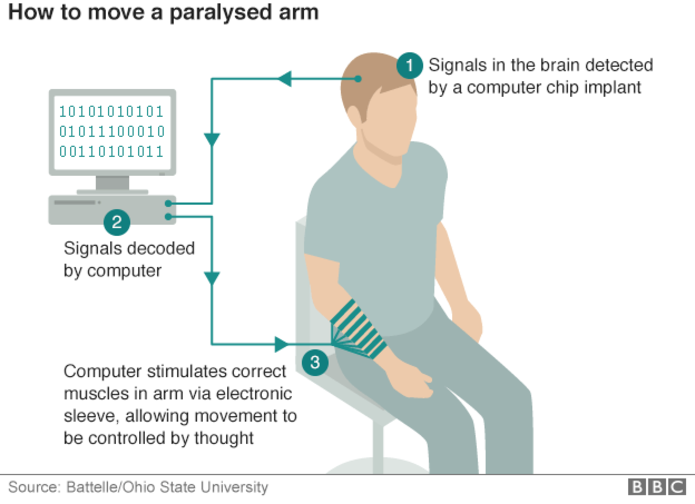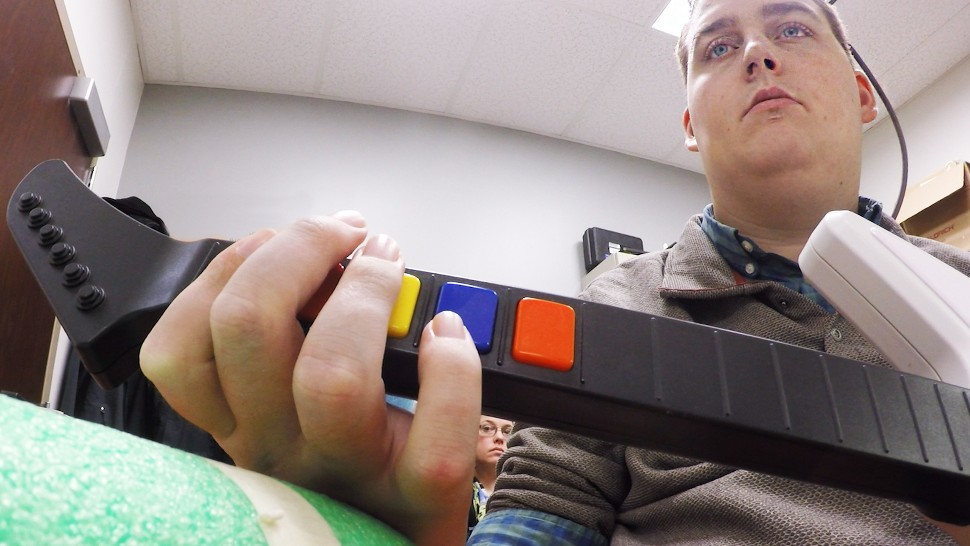Brain implant for the first time allowed a paralyzed person to control the arm

Almost six years ago, 19-year-old college freshman Ian Burkhart plunged unsuccessfully into the sea and, by unfortunate coincidence, broke his neck against a sandy bottom. He was completely paralyzed, lost his ability to control his arms and legs. Such injuries have always been considered incurable. Until yesterday.
On April 13, 2016, experts at Ohio State University announced that they were able to regain partial control of the right hand and fingers of Berkhart. An experimental cybernetic technology was used for the treatment: a chip implanted into the brain sends signals directly to the muscles, bypassing the spinal cord. This is the first in the history of medicine case of restoration of control over the brush in a patient with quadriplegia .

The implant is connected via a computer interface to a sleeve with 130 electrodes on the arm. For two years after the introduction of the chip, Ian trained to focus his thoughts, observing the results on a computer screen in the laboratory. As a result, the training brought success.
Of course, the control of the hand and fingers severely limits the arsenal of movements. Ian is paralyzed below the chest, retaining partial control only of the shoulders and biceps. Now he got the opportunity to press buttons, play computer games, perform many other actions.

Paralyzed man playing Guitar Hero

Brain surgery carried out in 2014. Previously, tomography was performed to determine a specific area that is responsible for the movement of the limbs in the motor cortex in the anterior central gyrus of the left hemisphere (just above the ear). During the operation, this area was thoroughly tested to clarify the location for the implant.
“We spent an hour and a half determining the exact location,” said Ali Rezai, surgeon and director of the Neuromodulation Center at Ohio State University.
A chip with 96 contacts (microelectrodes) was placed in this place, which record the activity of neurons.
After surgery and recovery began numerous training. The software for processing the brain signal was created by scientists from the non-profit Battelle Memorial Institute. After each training session, the program was calibrated because the signal changed significantly from workout to workout.
Ian Berkhart says the workouts were exhausting. “Avatar” on the computer screen (3D-model of the hand) made him try different types of movements.

The signal was transmitted to a sleeve with 130 electrodes. “I had to concentrate very, very much just to do things that I had previously done without thinking at all,” says Ian. “But it's like a sport, you try again and again, and gradually it becomes easier.” The first results appeared after a few months, then for the first time he was able to move the brush himself, without the help of an avatar.
After a year of training, he could already take a bottle, pour the contents into a mug, take a straw with his fingers and drink.

In the end, according to the American medical classification, his disability could be reclassified from degree C5 to less severe C7.
Unfortunately, the financing of a research project ends this year, soon Berkhard will return home, where he will return to his former life of an almost completely paralyzed disabled person.
The results of scientific work published in the journal Nature (doi: 10.1038 / nature.2016.19749).
